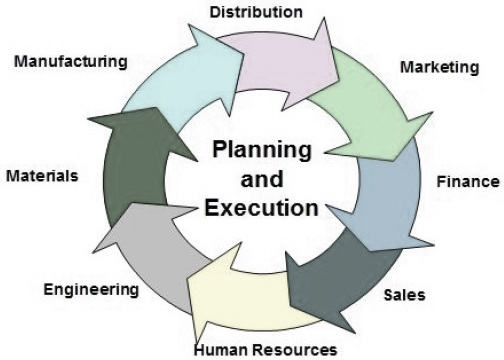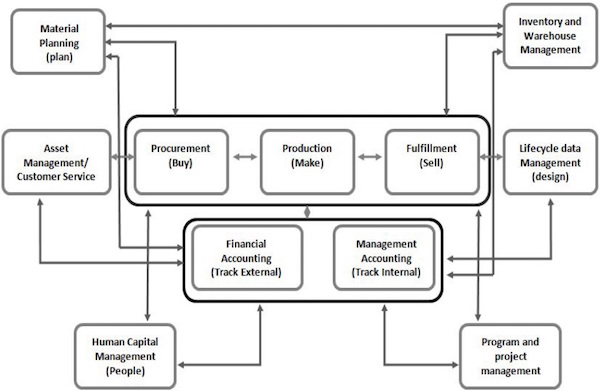
- SAP - Home
- SAP - Evolution of SAP
- SAP - Introduction To ERP
- SAP - Modules
- SAP - Architecture
- SAP - GUI Installation
- SAP - Net Weaver
- SAP - Logging onto SAP System
- SAP - GUI Customization
- SAP - End-User Customization
- SAP - GUI Navigation
- SAP - Programming Language (ABAP)
- SAP - SAP Security
- SAP - SAP Basis
- SAP - Transaction Codes
- SAP - Project Lifecycle
- SAP - Career In SAP
SAP - ERP Introduction
SAP is a market leader in providing ERP (Enterprise Resource and Planning) solutions and services. In this chapter, we will try to understand more on ERP and where it should be used. In addition, we will learn the implementation techniques of ERP along with the ERP packages available in the market.
What is ERP?
Enterprise Resource Planning (ERP) is a software that is built to organizations belonging to different industrial sectors, regardless of their size and strength.
The ERP package is designed to support and integrate almost every functional area of a business process such as procurement of goods and services, sale and distribution, finance, accountings, human resource, manufacturing, production planning, logistics & warehouse management.

Business Process Integration
Every business, regardless of the industry they belong to, require connected systems with efficient information flow from one business process to another. Business Process Integration (BPI) plays an important role in overcoming integrating challenges that allows organizations to connect systems internally and externally.
Business Process Integration (BPI) allows −
- automation of business processes,
- integration of systems and services,
- secure sharing of data across numerous applications, and
- automation of management, operational, and supporting process.
The following illustration shows an overview of various business processes running in an enterprise and how they are integrated.

Evolution of ERP
During early phases of development, integrated solutions were designed for particular process areas such as −
- Material Management − the integrated system was known as Material Requirement Planning (MRP)
- Manufacturing − the integrated system was known as Manufacturing Resource Planning
However none of the integrated systems came with a complete solution for an organization covering major business process areas. In early 1990s, the Gartner Group first used the acronym ERP. By mid1990s, ERP systems addressed all the core enterprise functions.
In the early stages, most of the ERP solutions were focused on automating back office functions that were not directly affecting customers or general public. Later, front office functions such as customer relationship management and ebusiness systems were integrated.
Functions of ERP
An ERP system typically performs the following functions −
Supports the integrated business process inside the organization.
Improves capital planning and helps in executing organizational plans and strategies.
Helps speed up the decision-making process over the analysis of accurate data.
Helps extend the business network to wider domains, expanding the products and services to reach more customers, suppliers, and partners.
Identifies operational risks to improve governance.
Provides protection against organizational data breaches and security threats to leakage of information.
Makes the organization adaptable to the rapid changes in the business process according to the needs.
Gives long-term profit by providing means to increase the customer base.
Functional Areas
ERP is a business management software is usually a suite of integrated applications that a company can use to collect, store, manage, and interpret data from many functional areas including −
Financial Accounting − Deals with financial transactions and data.
Human Resource − Deals with information related to employee of an organization.
Customer Relationship Management − Deals with capturing and managing customers relationship, facilitating the use of customer experience to evaluate the knowledge database.
Sales and Distribution − Deals with order placement, delivery, shipment and invoicing.
Logistics and Warehouse Management − Deals with storage of products and shipment.
Manufacturing and Material Management − Deals with the production and production planning activities.
Supply Change Management − Deals with the movement of products, storing, managing, and controlling supplies.
Business Intelligence − Analyzes data and converts the same to information.
Advantages of ERP
By integrating the business processes, the ERP offers the following advantages −
Saves time and expenses.
Allows faster decision-making by the management, utilizing the data and reporting tools designed in the systems.
Single data source and sharing of data among all the units of an organization.
Helps in tracking every transaction that takes place in an organization, from starting till end.
Supplies real-time information whenever required.
Provides synchronized information transfer in between different functional areas such as sales, marketing, finance, manufacturing, human resource, logistics, etc.
Disadvantages of ERP
It is not always easy to incorporate ERP in an organization. ERP suffers from the following drawbacks −
Sometimes business processes critical to an organization are to be re-engineered to align them with an ERP solution.
Cost of complex integration can be very high.
Switching from one ERP solution to another increases the implementation cost even further.
End-users are to be trained for their daily operations.
Customization is not preferred.
ERP Packages
Many companies develop and implement various ERP packages according to their budget and requirements to help them meet their business needs and run their business efficiently.
The following link takes you to a page from Wikipedia where you can find a list of almost all the ERP packages designed worldwide.
http://en.wikipedia.org/wiki/List_of_ERP_software_packages